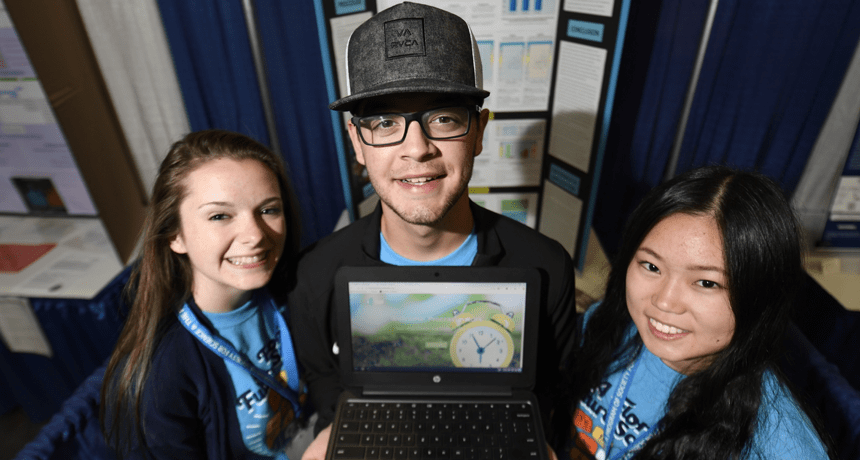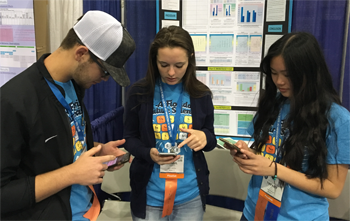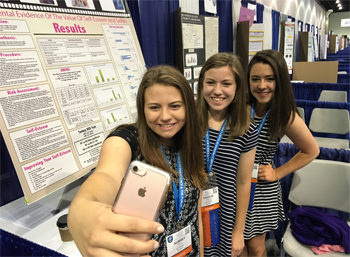Teens take on science in the age of smartphones
Two groups of high school students study how the Digital Age is impacting them and their classmates

Abigail Lifferth (left) Carter Draney (middle) and Tiffany Liu (right) show off the website they started to stop teen procrastination.
Chris Ayers/SSP
Share this:
- Share via email (Opens in new window) Email
- Click to share on Facebook (Opens in new window) Facebook
- Click to share on X (Opens in new window) X
- Click to share on Pinterest (Opens in new window) Pinterest
- Click to share on Reddit (Opens in new window) Reddit
- Share to Google Classroom (Opens in new window) Google Classroom
- Click to print (Opens in new window) Print
LOS ANGELES, Calif. — Many teen science fair projects take inspiration from the world around them. And in this Digital Age, the smartphone in your hand can be a good place to start. Now, two groups of teens have tackled how their phone use is changing them. One group looked at smartphones and procrastination, creating a website to help their classmates stop putting off homework. The other took inspiration from their own obsessions with selfies to ask what posting self-portraits has to do with self-esteem.
Both groups presented their projects here at the Intel International Science and Engineering Fair. The fair, created by Society for Science & the Public and sponsored by Intel, brings together high school students from around the world to share their research with the public and each other. This year, almost 1,800 students from more than 75 countries are taking part. (The Society also publishes Science News for Students and this blog.)
Ever since people have had boring or difficult things to do, they’ve been putting them off in favor of things that are more fun. But procrastination is easier than ever, thanks to the smartphones that many teens have in their hands.
Tiffany Liu, 17, Abigail Lifferth, 17, and Carter Draney, 17, are no strangers to the pull of putting things off. “First we noticed it in ourselves and then we noticed it in our classmates,” Abigail says. “We thought we should do a project on it to reduce the problem of procrastination.”

All three are juniors at The Villages Charter High School in The Villages, Fla. They designed a survey for 132 of their fellow high school students. It asked how often they caught themselves turning in assignments late, getting too little sleep or showing up late to activities. It also asked how often they caught themselves running late or putting off assignments because they were caught in the glow of their smartphones.
As smartphone use increased, so did procrastination, the teens found. Those who used their smartphones more were likely to get less sleep. The results surprised the students who took the survey, Carter notes. “Most people didn’t even know they were doing it,” he says of their procrastination. “Some were disappointed in themselves, and [wondered] ‘Why did I do that?’”
Could awareness of this habit help? To find out, Tiffany, Abigail and Carter had a group of students download apps that track how much they use their smartphones. T(here are several apps that do this, including Moment, Quality Time, Menthal and BreakFree.) Over three days, 20 high school volunteers tracked how much they used their phones.
For those who used their phones a lot, tracking their use made them realize just how much they did it — and helped them to cut back. That included the young scientists themselves.
“When I first downloaded the app, I [found out] I spent eight hours one day, which was completely shocking,” Tiffany says. “It’s a minute here, a minute there. It adds up so fast.” She knew spending a third of her life on her phone probably wasn’t a great idea. Now, knowing how much time she had been spending on the phone has brought Tiffany’s behavior in line. She has cut her phone time to less than two hours a day.
And the team didn’t stop there. They wanted to use their findings to help others put down their phones and stop procrastinating. To do this, they started a website: Teens Against Procrastination. “It’s actually a social network that fights fire with fire,” Tiffany explains. “Even though social media is the main reason teens are procrastinating, this is creating a familiar platform for them so they can connect with other teens that have the same problem.” The site lets students discuss how to fight procrastination and how to share their successes and failures.
The site already has more than 400 users. The team hopes that in the next year they will prove the link between smartphone use and procrastination. They also want to spread the word about their website, to help more teens stop putting off until tomorrow what they can do today.
My selfie, myself
While putting off your homework, maybe you’ve taken and posted a few selfies. It seems like people who take a lot of selfies might have high self-esteem. After all, you wouldn’t take so many photos of your own face if you weren’t a fan. But is that really true? Aubrey Wells, 18, Kaitlin Wells, 16 and Kaybree Keating, 15, decided to find out.
“You see people all over taking selfies,” says Kaitlin, a sophomore at Fort Morgan High School in Colorado. “You hear a lot about self-esteem. Some people say social media doesn’t affect your self-esteem, and some people say it does. We thought maybe we’ll just look and see.”

Teens live in a sea of selfies, points out Kaybree, a sophomore at Weldon Valley High School in Weldona, Colo. “It’s a part of our generation,” she says. “I think a thing that happens a lot is comparing yourself to other people. That could really affect self-esteem.”
The team hypothesized that people with high self-esteem would take and post more selfies than would people with low self-esteem. To find out if they were right, they sent out surveys to both Fort Morgan High School and Weldon Valley High School. The surveys asked questions from the Meyers-Briggs test, a survey used to characterize people’s personalities. The teens also included questions from the Rosenberg self-esteem scale. It measures how people feel about themselves.
The team received 556 responses to its survey. Students take a lot of selfies, they found. More than half of those surveyed took between one and 10 selfies per week (56 reported taking more than 20 per week).
Was a high number of selfies linked to high self-esteem? Sort of. “People with high self-esteem took more selfies,” but posted fewer of them, Kaybree says. People with lower self-esteem took fewer selfies but posted more of them.
Aubrey, a senior at Fort Morgan High School, says people with low self-esteem might post more selfies because the feedback makes them feel better. “The gratification of getting likes, comments [and] stuff [makes] them feel like their selfies were good and gave them more confidence,” she says. Their data show that 21 percent of their fellow students posted selfies “to boost their self-confidence,” and 18 percent posted selfies “because they enjoyed the positive feedback.”
Overall, the team found, most of the students they surveyed felt pretty good about themselves. “A lot of teenagers say they have low self-esteem and it’s a big issue,” says Aubrey. “But when we looked at our survey, the majority of people had really high self-esteem.” Overall, 16 percent of boys and 32 percent of girls reported low self-esteem.
So far, the team has linked high self-esteem and taking selfies. But to know whether taking selfies themselves are good or bad for self-esteem, they’ll have to do more research.
And maybe take a few more selfies.
UPDATE: For their project, Tiffany, Carter and Abigail received a $500 award at Intel ISEF in the Behavioral Sciences category.
Follow Eureka! Lab on Twitter







